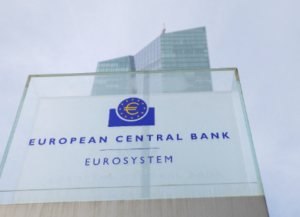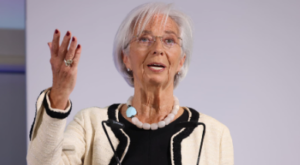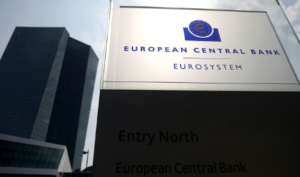FRANKFURT — The European Central Bank (ECB) is expected to cut interest rates by 25 basis points on Thursday, just days before the U.S. Federal Reserve is set to make its own rate-cutting decision. This move is widely anticipated by traders as central banks around the world respond to declining inflation and concerns over economic growth.
The ECB’s key interest rate currently sits at 3.75%, following years of aggressive rate hikes aimed at curbing inflation. However, with inflation in the Eurozone showing signs of decline, the central bank is now shifting its focus towards stimulating growth. In August, headline inflation fell to a three-year low of 2.2%, but core inflation remains more stubborn at 2.8%, primarily driven by rising service prices.
ECB’s Rate Cut Expected Amid Lower Inflation
Holger Schmieding, the chief economist at Berenberg Bank, highlighted that the upcoming rate cut is “largely uncontroversial,” with broad support across the ECB’s governing council. Even Joachim Nagel, President of the traditionally hawkish Bundesbank, has indicated support for a reduction unless there’s significant contrary evidence.
The ECB had already left rates unchanged in July following a landmark cut in June, and at the time, policymakers described the potential for further cuts in September as “wide open.” Recent data has reinforced the need for action, particularly as confidence in the Eurozone economy weakens. The services sector, in particular, is showing signs of vulnerability, with Société Générale’s Anatoli Annenkov warning that weakening domestic demand could exacerbate a slowdown in manufacturing and labor markets.
What’s Next for the ECB?
Following Thursday’s expected rate cut, attention will turn to the ECB’s next meeting in October, where the central bank may pause to assess the impact of its policies. Some analysts, however, suggest that the ECB might accelerate its rate-cutting cycle to prevent keeping rates too high for too long, a risk that Philip Lane, the ECB’s chief economist, highlighted at the Jackson Hole economic symposium last month.
Lane warned of the potential for “chronically” below-target inflation if the ECB remains overly cautious, even as inflation approaches its target of 2%.

Global Implications and Fed’s Big Decision
The ECB’s decision comes just days before the U.S. Federal Reserve’s meeting on Sept. 17-18, where traders are also expecting a rate cut. The coordinated timing of these cuts by two of the world’s largest central banks underscores the delicate balance that monetary policymakers must strike between fostering economic growth and managing inflationary pressures.
As the ECB prepares for its rate cut, the broader Eurozone economy remains fragile. New staff projections from the ECB on Thursday are unlikely to show significant revisions to inflation or growth figures, but economists warn that the growth outlook could be grimmer than in July. With uncertainty still looming over the European economy, all eyes are on the ECB and the Fed as they navigate this challenging economic environment.
The ECB’s ability to stabilize inflation without triggering further economic slowdown will be critical in the coming months, with potential ripple effects across global markets.
ECB’s Bold Move to Revive Eurozone Economy
With Eurozone inflation easing, the ECB is seizing the moment to pivot from its previous aggressive tightening stance. August saw headline inflation drop to a three-year low of 2.2%, a sign that the central bank’s efforts to tame price pressures are bearing fruit. However, core inflation remains elevated at 2.8%, driven largely by soaring prices in the services sector.
Holger Schmieding, chief economist at Berenberg Bank, notes that the ECB’s decision to lower rates is “largely uncontroversial,” with strong backing from key members of the central bank’s governing council. Even Joachim Nagel, the typically hawkish President of Bundesbank, has signaled his support for the cut, highlighting the urgency of addressing sluggish growth and weakening consumer confidence across the Eurozone.
A Critical Moment for Europe’s Economy
The ECB’s current key interest rate stands at 3.75%, following a series of hikes aimed at controlling inflation. But with economic momentum stalling, the Frankfurt-based institution is under mounting pressure to stimulate demand. Economic data indicates that domestic demand has weakened in the second quarter, with the manufacturing sector faltering and labor markets showing signs of strain.
“The most concerning data is the weakening confidence, particularly in the services sector, which is on shaky ground,” warned Anatoli Annenkov of Société Générale in a recent note.
The ECB is expected to release updated economic forecasts this Thursday, and many economists anticipate a downward revision in growth projections, reflecting the growing challenges facing the 20-nation bloc that shares the euro.
ECB Strategy: Caution vs. Action
While the ECB’s rate cut this week is all but certain, the next steps are less clear. Analysts believe the central bank may pause in October to evaluate the effects of the latest cut. However, Philip Lane, the ECB’s chief economist, has expressed concerns that keeping rates too high for too long could risk pushing inflation chronically below the ECB’s 2% target.
At the Jackson Hole Economic Symposium last month, Lane emphasized the need for balance, stating, “The return to target is not yet secure,” but he also warned that overly tight monetary policy could stifle growth.
Global Implications: Eyes on the Federal Reserve
The ECB’s decision will have significant global repercussions, especially as the U.S. Federal Reserve prepares for its own interest rate decision on September 17-18. Traders widely expect the Fed to initiate its rate-cutting cycle in response to similar concerns over inflation and economic slowdown.
This synchronized move by two of the world’s most influential central banks highlights the delicate balancing act facing global policymakers as they attempt to steer their economies away from potential stagnation while maintaining price stability.

Looking Ahead: Risks and Rewards
As Europe braces for a potential slowdown, all eyes are on the ECB’s ability to navigate these turbulent waters. While a 25-basis-point cut is seen as necessary to reinvigorate growth, it remains to be seen whether this will be enough to prevent a more severe downturn.
The ECB’s next move, particularly its decision to either continue easing or pause, will be critical in shaping the future of the Eurozone economy. Financial markets will also be closely watching the U.S. Federal Reserve, whose decision could set the tone for global monetary policy in the months to come.
In the face of these challenges, the ECB must strike a balance between reviving economic growth and managing inflation, with the risks of inaction looming large over both European and global markets.






